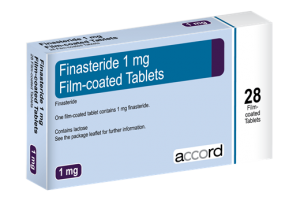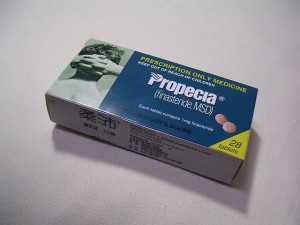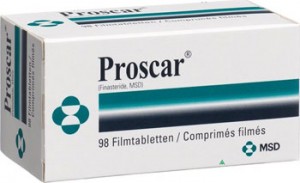Finasteride History and Overview
Finasteride is the generic name for the trade name drug more commonly known as Proscar. Finasteride was originally developed and manucatured by Merck pharmaceuticals, and was approved by the FDA for use on the prescription market in 1992 under the brand name Proscar. Initially, it was approved for use in treating benign prostate hyperplasia (BPH), which is the benign enlargement of the prostate gland. In 1997, however, the FDA approved Finasteride for use in the treatment of male pattern baldness (MPB). For the treatment of MPB, Finasteride is marketed under a different brand name: Propecia. The difference between Proscar and Propecia is that Propecia contains only 1/5th of the full Proscar dose.
Finasteride is used by bodybuilders and athletes for generally the same reasons that it is used within the medical establishment: to slow down or prevent male pattern baldness associated with Dihydrotestosterone (DHT), as well as to mitigate or prevent the possibility of benign prostate hyperplasia of the same cause. With the use of Testosterone – especially in high dosages – bodybuilders and athletes often encounter a distinct increase in the area of androgenic side effects, which can include: an increase in aggression, increase in bodily hair growth, oily skin, and acne, as well as the possibility of prostate enlargement and triggering male pattern baldness.
This is primarily the result of Testosterone converting into a much stronger androgen, Dihydrotestosterone (DHT). While Testosterone itself is moderately androgenic, DHT is several times stronger as a male androgen. Testosterone undergoes conversion (or more formally, reduction) into DHT by way of the enzyme known as 5-alpha reductase (5AR). This enzyme is present in high concentrations in tissues such as the scalp, prostate, and underneath the skin. When Testosterone circulates throughout the bloodstream and passes through these tissues, the 5AR enzyme will bind to a certain percentage of the Testosterone that is present, and reduce it into Dihydrotestosterone.
As we will learn shortly, Finasteride is an inhibitor of 5-alpha reductase, and this is method of activity that Finasteride works through in the body. It is important to note that 5AR inhibitors like Finasteride are successful only in reducing or preventing the conversion of Testosterone into DHT, and it is effectively useless if the athlete or bodybuilder is using other anabolic steroids that completely avoid the 5AR enzyme (or anabolic steroids that are already derivatives of DHT). Bodybuilders and athletes will typically use Finasteride in cycles with moderate to high dosages of Testosterone.
It therefore stands to reason that Finasteride will do absolutely nothing to mitigate, prevent, or stop any of the androgenic effects of anabolic steroids such as: Trenbolone, Nandrolone (Deca-Durabolin), Anavar (Oxandrolone), Winstrol (Stanozolol), Masteron (Drostanolone), and several other compounds.
Finasteride Chemical Characteristics
Finasteride is what is chemically known as a synthetic 4-azasteroid. As we have just learned, the 5-alpha reductase enzyme is responsible for the conversion of Testosterone into DHT in the body. Finasteride acts to prevent this process by binding to and inhibiting the 5-alpha reductase enzyme itself. Through this method of action, Finasteride can effectively drop the blood plasma concentration of DHT, and therefore mitigate and minimize the negative androgenic effects that are caused by high serum DHT levels. Research has demonstrated that 24 hours after administration of a 1mg tablet, Finasteride is effective at achieving serum DHT reductions by as much as 65%.
Specifically, Finasteride inhibits the Type-II 5-alpha reductase enzyme. In reality, there are actually two different variants of the 5AR enzyme in the body (Type-I and Type-II). The difference between the two is that one is found in higher concentrations of some body tissues than the other. In particular, the Type-I 5AR enzyme is found in higher concentrations in the liver and underneath the skin. The Type-II 5AR enzyme is found in higher concentrations in the prostate gland and the scalp. The Type-II variant is actually responsible for total higher concentrations of DHT in the body by 2/3rds than the Type-I, which is responsible for the remaining 1/3rd. As a result of Finasteride inhibiting Type-II only, it stands to reason that it would have a much better effect at preventing or treating MPB and hair loss than it is at tackling the other androgenic effects of oily skin / acne. The point here is that research has shown that although Finasteride is very effective as a DHT inhibitor, it is unable to block DHT conversion anywhere near 100%, nor will it do so equivalently in all body tissues where DHT is a concern.
Because it prevents Testosterone from undergoing reduction into DHT, studies have shown that Finasteride is able to increase circulating blood plasma levels of Testosterone by about 15%. This is, of course, due to the fact that Finasteride is leaving less 5AR enzymes to interact with Testosterone in the body.
Those considering the use of Finasteride for androgenic alopecia (hair loss), oily skin, acne, BPH, or any other negative androgenic effects need to understand that reductase inhibitors such as Finasteride do not provide 100% protection against these effects. Drugs like Finasteride merely mitigate or reduce/lessen these effects, not eliminate them. Likewise, Finasteride will not stop hair loss after it has begun, and nor can it reverse it, as it is commonly mistaken and misconceived to do.
Finasteride Side Effects
Finasteride is a drug that is considered very specific in its mode of action, and therefore has very little peripheral or residual effects in the body elsewhere, but it does have its potential side effects. Finasteride does not interact with the androgen or estrogen receptors, and therefore has no direct androgenic, estrogenic, anti-androgenic, or anti-estrogenic effects. It does not affect any other hormones in the body, such as Cortisol, thyroid hormones, Luteinizing Hormone (LH), or Follicle Stimulating Hormone (FSH). Research has even demonstrated it has no effects on cholesterol profiles.
However, research has shown that 8.1% of subjects and patients report impotence, 6.4% report a reduction in libido (sex drive), and a varying amount (less than 1%) report ejaculation issues, gynecomastia (development of breast tissue), and the odd rash.
The vast majority of Finasteride side effects are the result of its ability to reduce DHT levels in the body. It should be understood that DHT is a powerful androgen, and part of its responsibility is to maintain normal male secondary sex characteristics as well as sexual function. It stands to reason that reducing the circulating blood plasma levels of DHT will result in a corresponding reduction of both the positive androgenic effects of DHT as well as the negative ones. This is very important and should be kept in mind by those considering use of Finasteride. Additionally, research and studies have shown that strong androgens actually play a role in the body as anti-estrogens. This is true for DHT, and when blood plasma levels of DHT are reduced by Finasteride, Estrogen can sometimes gain an ‘upper hand’ and some users will therefore experience some degree of estrogenic side effects, such as gynecomastia and breast tenderness.
Dosing and Administration of Finasteride
For the treatment of androgenic alopecia (male pattern baldness) in males, the prescribed medical dosage is usually 1mg daily for 6-12 months. For the treatment of BPH (prostate enlargement), a higher medical dose is prescribed, which is usually 5mg daily for an extended duration.
Bodybuilders and athletes looking to reduce the androgenic effects of Testosterone conversion into DHT, the recommended Finasteride dosage is 1mg per day for the duration of use that Testosterone is used. Many athletes and bodybuilders also take the approach with Finasteride that it should be used only when necessary, and not automatically taken all the time whenever a cycle is run.
Finasteride is commonly found in tablets of 1mg and 5mg.
Finasteride Legality
Every individual should be well aware of the laws and regulations concerning the use and possession of ancillary drugs such as Finasteride in their respective countries and/or regions. In most major countries including Canada and the United States, Finasteride is a non-controlled substance. Many ancillary compounds fall under this classification, such as anti-estrogens, sympathomimetics, and many other prescription drugs that are not classified as controlled substances under the CSA (Controlled Substances Act) or the Canadian CDSA (Controlled Drugs and Substances Act). The same is true in the UK.
Although Finasteride is not a controlled substance, it cannot be purchased over the counter in most major Western countries, as it is regarded as prescription-only and is only available through a valid physician’s prescription. There are no criminal penalties in regards to its use, possession, or trade. Under an FDA 1988 ruling, it is permissible to import a 3-month supply for personal use both in the United States as well as Canada. Some European countries, such as Greece or Turkey, do sell Finasteride and other ancillary compounds over the counter in some pharmacies.
How to Buy Finasteride
Finasteride is a very common ancillary drug in the bodybuilding and athletic circle, and is therefore very common and widely available on the market in most areas of the world. It is fairly cheap and can be found commonly under its brand names of Proscar (5mg tablets) and Propecia (1mg tablets). Several other generic (as well as brand name) pharmaceutical forms of the drug can be found. Additionally, several research chemical companies have been offering Finasteride in their line of products as a research chemical for research purposes only.
Finasteride can be easily found online on online web shops, as well as through traditional anabolic steroid sources, both online, mail-order, as well as in-person ‘gym dealer’ sources. Depending in which store or source it is purchased from, the price of Finasteride can vary widely. However, its average pricing can be in the range of $0.40 per 1mg tablet on the high end, and as low as $3.00 per 1mg tablet on the low end. For the 5mg (Proscar) tablets, they can be found for as low as $0.40 per 5mg tablet, or as high as $2.40 per 5mg tablet, depending on the source.
Finasteride Pictures:







